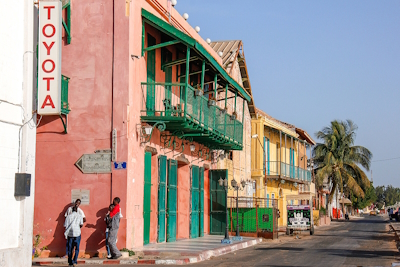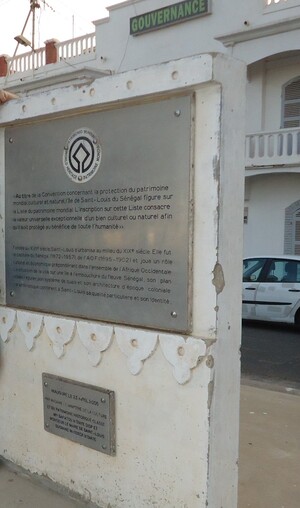Island of Saint-Louis

The Island of Saint-Louis holds a characteristic French colonial city and oceanic port.
Saint-Louis was the capital of the French colony of Senegal from 1673 until independence in 1960. It has preserved its colonial architecture with magnificent residences and its regular town plan. The site also includes the 19th-century Faidherbe Bridge.
Community Perspective: The Island of Saint-Louis isn’t gentrified and you may encounter rubbish and poor living circumstances. Its strength lies in the homogeneity of its French colonial architecture.
Map of Island of Saint-Louis
Community Reviews
Els Slots

As with all of Senegal’s WHS, this one is underreviewed. So I am glad to present the situation that I encountered when visiting in January 2025. I arrived by minibus (“combi”) from Dakar’s Gare Routière des Baux Maraîchers, a 5-hour ride mostly because of strong traffic congestion one-third of the way in Thies. The bus will drop you at the bus station on the mainland of Saint-Louis, from where it’s a short taxi ride across the Faidherbe Bridge to the island. The bridge, like the rest of the colonial heritage, dates from the late 19th century so is part of the inscribed area. It looks like a horizontal Eiffel Tower.
The urban layout on the narrow strip that comprises the island follows a rigid rectangular plan. So, the best way to explore is to walk one street up and the next street down. Most notable in the architectural design of the colonial buildings are the wrought-iron balconies, wooden shutters and the use of bright colours. There’s a mosque, a church, a post office, and administrative buildings, all dating back to the heydays of Saint-Louis when it was the French colonial capital of Senegal. No building stands out though, its strength lies in its homogeneity overall. Pictured is 'Les Signares', named after the wealthy Métis (mixed race) women who formed an aristocracy within the town and held society meetings and balls in their residences.
In contrast to what Jarek found in 2018, the streets are clean and not too much rubbish has washed ashore. Or maybe I have just become immune to dirt, having recently spent a month in India. Still, a fair number of the old buildings are in a bad state and the living conditions of the people don’t seem great either. The island isn't gentrified despite a few coffee shops, hotels and restaurants. Comparisons with Cuba are easily made, but it is not as good as Havana and more similar to Camagüey.
I stayed in the core zone for two nights in one of those fine old houses, the Ndar Ndar House, with a rickety wooden balcony adorned with wrought-iron grilles attached to my room. I didn’t dare to put my full weight on it…
Jarek Pokrzywnicki

Site visited in April, 2018. Located some 300 km from Dakar to the north, close to Mauritanian border. From Dakar Gare Routiere there are mini buses (stand is located in the middle of bus station) but despite good asphalted road it took full day to reach Saint-Louis, including waiting time in Dakar (in most cases the cars leave when full, leaving hours are not specified). So when you start the journey in the morning it is possible to get to the place late in the afternoon or in the evening the same day.
While approaching Saint-Louis you will encounter huge garbage dump (some 10 km before the town). It is just for you to be prepared what you can expect in the town. And that is terrifying. Rubbish are everywhere, the streets are dirty but more appalling is what you see in the water and areas nearby (have in mind that this is an island). Of course not everywhere. Some streets in the center are more clean but overall first impression is somehow discouraging.
Historic centre of Saint-Louis is located on the island, within the estuary of Senegal river, linked with the land by Faidherbe Bridge (interesting landmark, metallic, from the end of XIX century). It has regular rectangle shape and adapted streets layout. Apart from the bridge other important places are former catholic church (closed), Grande Mosquée de Saint-Louis, Faidherbe square, post office, building of Office Du Tourisme-Syndicat D'initiative de Saint-Louis. If you forget the rubbish nice photos may be taken with boats around Quai Giraud. All places are accessible on foot within few hours and one day is pretty sufficient to see everything, another one is necessary if you plan to go to Djoudj.
Some practicalities: there are many hotels (different standard) on Saint-Louis Island. I stayed at Café Des Arts (in northern part of the island, Quai Giraud) but it is rather budget accommodation. There are a lot of restaurants (most of them are located in central part). For located nearby Djoudj National Bird Sanctuary try to organize a trip (there are several agencies in the town – most of them are located in the center; other option is to use Office Du Tourisme).
Community Rating
Site Info
Site History
2000 Inscribed
Site Links
Connections
The site has 20 connections
Constructions
Damaged
Ecology
Geography
History
Human Activity
Individual People
Religion and Belief
Timeline
Trivia
WHS Names
WHS on Other Lists
Visitors
71 Community Members have visited.
